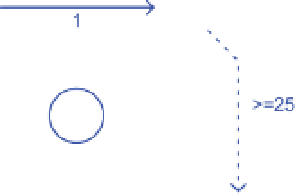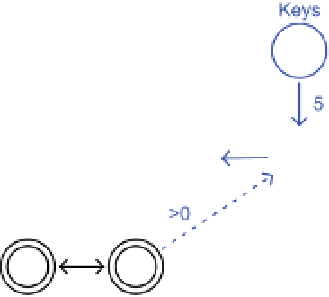Game Development Reference
In-Depth Information
We can create a more interesting mechanism by applying the
dynamic engine
pattern
to the mechanism.
Figure 11.14
represents such a mechanism. This time, the player
needs to collect 25 or more keys to proceed, but now she has the option to invest 5
keys to increase the harvest rate by 0.5. However, this mechanism is probably too
simple. It is not very difficult to find out what number of upgrades is ideal for this
scenario (which also depends on the speed with which the player can move between
the different locations in the game). Worse, a disadvantage of this mechanism is
that it is optional: The player can reach the goal without upgrading at all. These
weaknesses should not come as a surprise: As we argued in Chapter 6, one feedback
loop alone is generally not enough to create an interesting dynamic mechanism.
FIGURe 11.14
applying the dynamic
engine pattern to the
mechanism
The emergence of a dominant strategy in the form of an ideal number of upgrades is
the direct result of the
dynamic engine
pattern. We have seen similar patterns already
in our discussions of
Monopoly
and the Harvester game. Games that mostly rely on
a dynamic engine as their sole, or single most important, feedback loop, as is the
case with
Monopoly
, usually include random factors to make it more interesting
and unpredictable. That would be an option, but it is not the direction we want to
explore here.
NOTE
if this idea of
dynamically generated
keys seems strange to
you, remember that
we don't necessar-
ily mean physical keys
for physical locks in
physical doors. many
construction and
management simula-
tions require players
to master part of their
economy to unlock
new buildings or other
features. a role-playing
game could use such
a system as the key to
solving a quest: The
blacksmith will reward
you if you can take over
his business and make
it profitable.
To create a more interesting lock-and-key mechanism, we can complement the
dynamic engine
pattern by some form of
dynamic friction
(
Figure 11.15
). In this case,
enemies spawn that will steal and consume the harvested keys from the player.
Now the player has to balance between three tasks: harvesting, upgrading, and
fighting the enemies, whose numbers increase over time unless the player destroys
them. This is no longer a trivial challenge; beating the interactive version of the
Machinations diagram is already fairly tough and less straightforward than it looks.
Simply harvesting will probably not bring the player very far, and although it is pos-
sible to achieve the goal by switching between harvesting and fighting, this requires
the player to maintain a delicate rhythm of switching between the two for a long
time; it is very hard to accomplish. The player needs to find a balance between the
three actions to reach the goal. When the fighting is made skill-based, then the
most effective balance can actually vary depending on the individual player's level
of skill.







